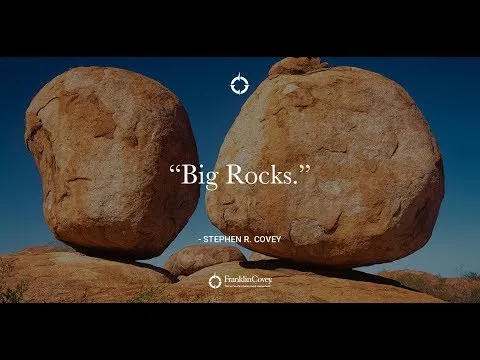Franklin Covey training, specifically Stephen Covey, popularized an idea of the paradigm of scheduling and making time for the "big rocks" in your life first. Once you have the big rocks set, you can use the time around them to manage all of the small stuff - lower priority items. This video illustrates the idea and is one I've used many times in classes & workshops.
In order to enact this concept, you need to know what your priorities are. A good way to do this is to create a list of priorities that you can refer to when you need to. In this article, I'll share a way I like to use to create my priority list.
Overcoming Resistance
It can feel daunting to list your priorities. Every time I refine my list, I feel immediately better...followed almost immediately by a feeling of complete overwhelm. When you aren't clear on your priorities you don't have as much worry about what you're letting slip. But, when you list your priorities, you can easily see where you may not be hitting the marks.
Time is our most precious resource. Time is non-refundable. You cannot transfer it. You cannot get more of it once it is gone. So, our priorities are a way of expressing and planning how we will spend that most precious resource. They are also a way of assessing how we spent our time.
Whether you feel like you have a good handle on your priorities, or if you've never tried to list your priorities before, I hope this simple process helps you to create (or refine) your list of priorities.
A Simple Process to Create (or Refine) Your Priority List
There is no right way and no wrong way to create a list of priorities. I'm going to recommend a way that I've done this many times over the years. Use what you want and discard the rest.
Step 1: Block 10 - 20 minutes on two different days on your calendar for this exercise. Schedule this time with yourself at the time of day you feel most thoughtful. For me, this is early morning.
Session 1
Step 2: During the first session, grab fresh paper and a pen or open up a doc on your computer.
Step 3: Start writing about priorities. You can create a bullet list. You can do free form journaling. Do what works for you.
Step 4: If you have extra time in the first session, consider the questions below. Answer as few or as many of these questions as make sense for you. Remember - this is about how you find meaning and how you focus your time so it must work for you.
- How do you think about your priorities? Are they values, people, events, life segments, pillars, etc.?
- Who - people or groups - are priorities for you?
- How many priorities will feel like too many for you? How many will feel like too few?
- Where do you represent yourself in your priority list?
- How do you want to represent your work in your priority list?
- How does your priority list reflect your values and/or passions?
Step 5: When the time is up on your first session, put the document away in a safe place/save it somewhere you can easily find it. Take a short break (5 - 10 minutes) to let your mind ease out of the focus you were in so you can move on to the next thing on your calendar or to do list.
Session 2
Step 6: Open your document back up/pull it back out. Even though you've not been working on it, the idea has been in your brain and you likely will have a burst of additional thoughts. Get those down quickly.
Step 7: Now, organize your list in some form or fashion. There are as many ways of organizing as there are people in the world. Here are a few things that might resonate with you as you try to organize and simplify (remember - you don't have to use any of these):
- High, medium, and low
- Group in categories
- High energy, medium energy, and low energy
- Rank order
- Build some sort of matrix or grid
- Color codes
Spend only the time allotted. Aim to do the best work you can to get to a final product in the time you have. The constraint of limited time will either frustrate the heck out of you or push your creativity in ways you might not have even thought possible.
Step 8: With the last 3 - 5 minutes of your session, make sure that you have a final list and post it somewhere that you'll see it and remember it. If I've done this by hand, this is the point where I love to take a photo with my phone of my final list. Perhaps it will be your new phone wallpaper.
Summary
Now that you have a list of priorities, we have to use them. In upcoming articles, I'll talk about a variety of ways I use my priority list.

